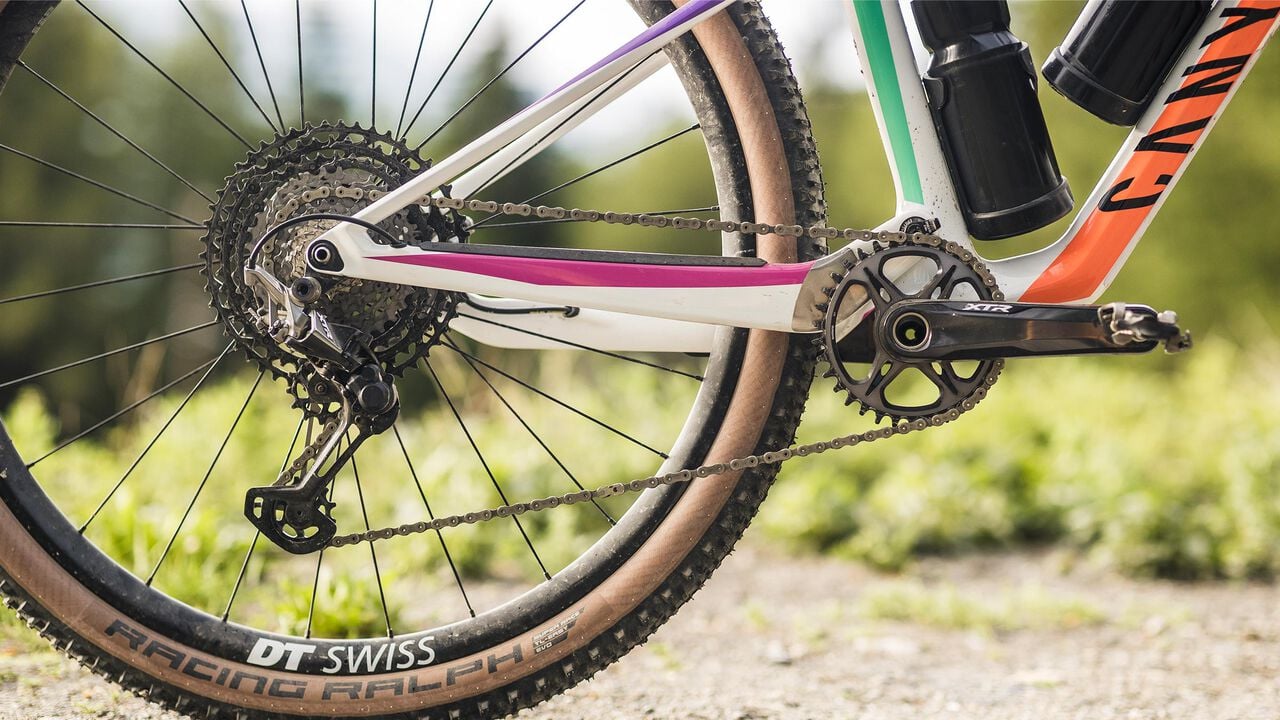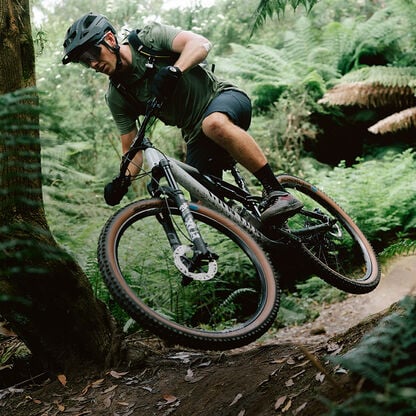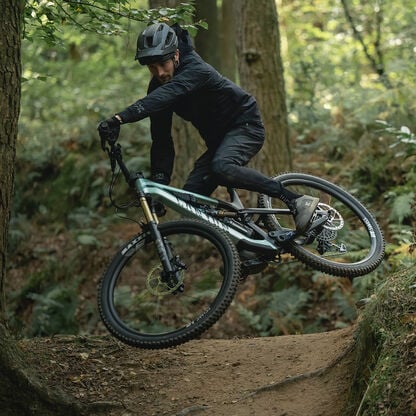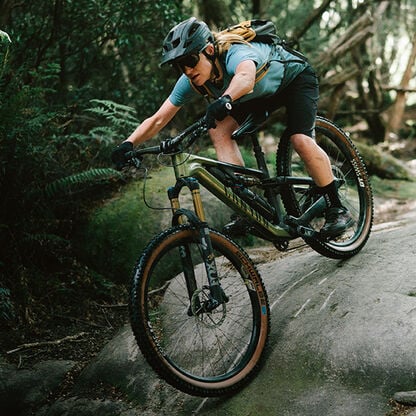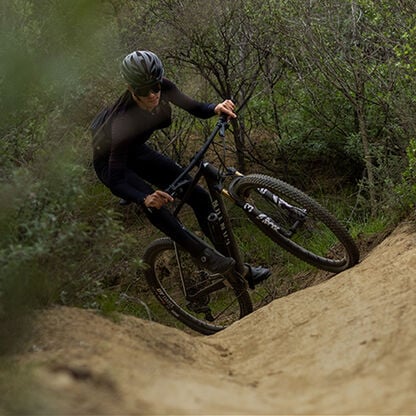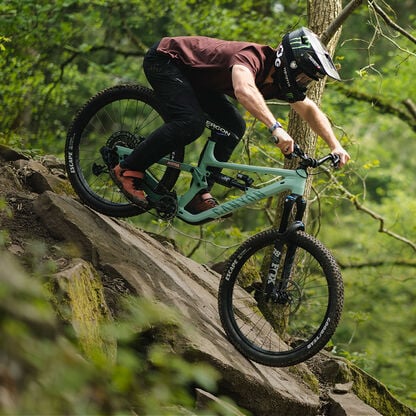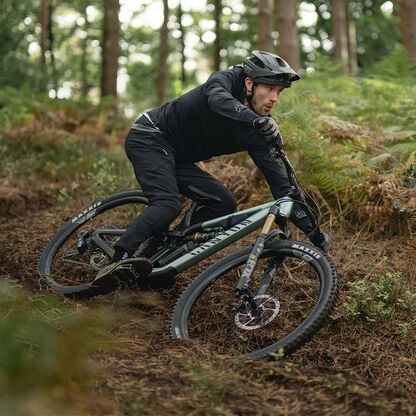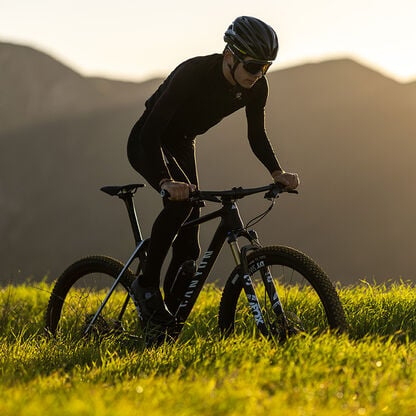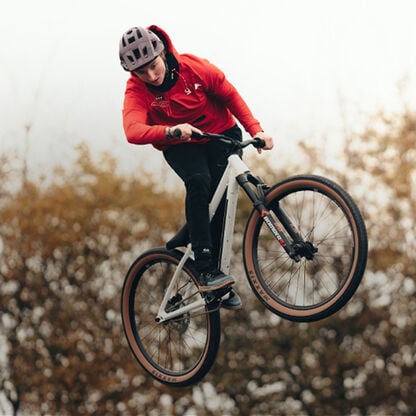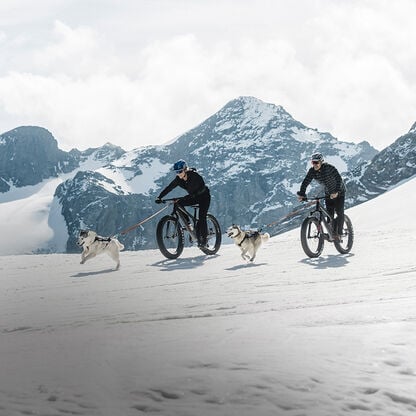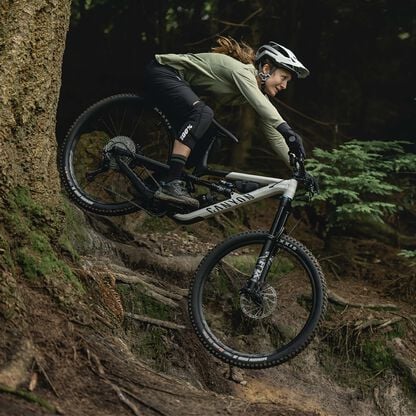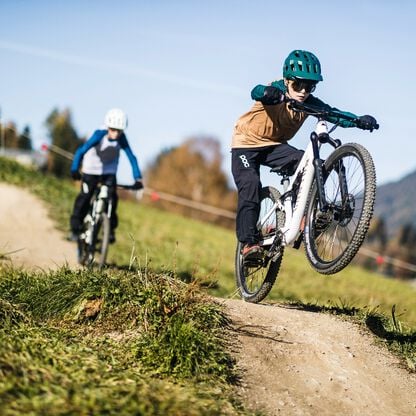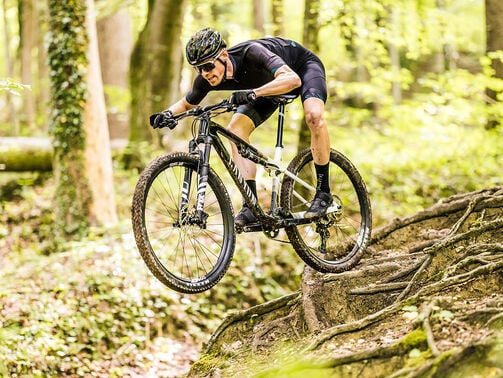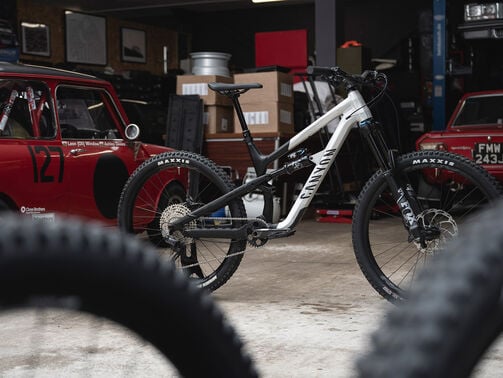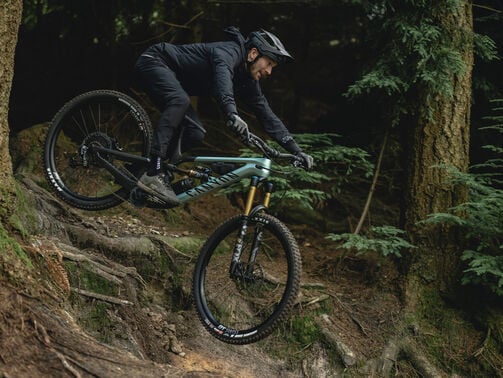1x12 mountain bike drivetrain: advantages, technology and conversion
We are going all-in on 1x12 MTB drivetrains. We compare the most recent 1x12 MTB groupsets from Shimano and SRAM.
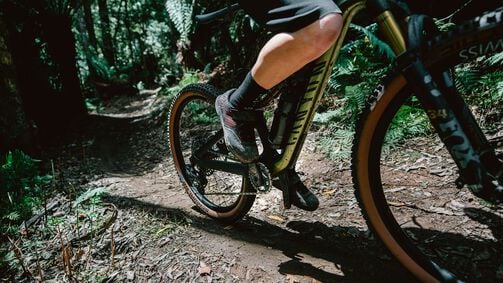
We take a look at the advantages and disadvantages of these 12-speed drivetrains and provide tips on components and upgrade options.
What distinguishes a 12-speed drivetrain for mountain bikes?
12-speed drivetrains for MTBs feature an additional twelfth sprocket on the cassette, providing 12 gears on the rear wheel. This is the result of continuous development of chain drivetrains over the last few decades. Starting with only 8 sprockets on the rear wheel, the shifting systems for MTBs, road bikes, and gravel bikes have now evolved to feature 12-speed cassettes. The cassettes are becoming more tightly packed, resulting in a larger number of gears.
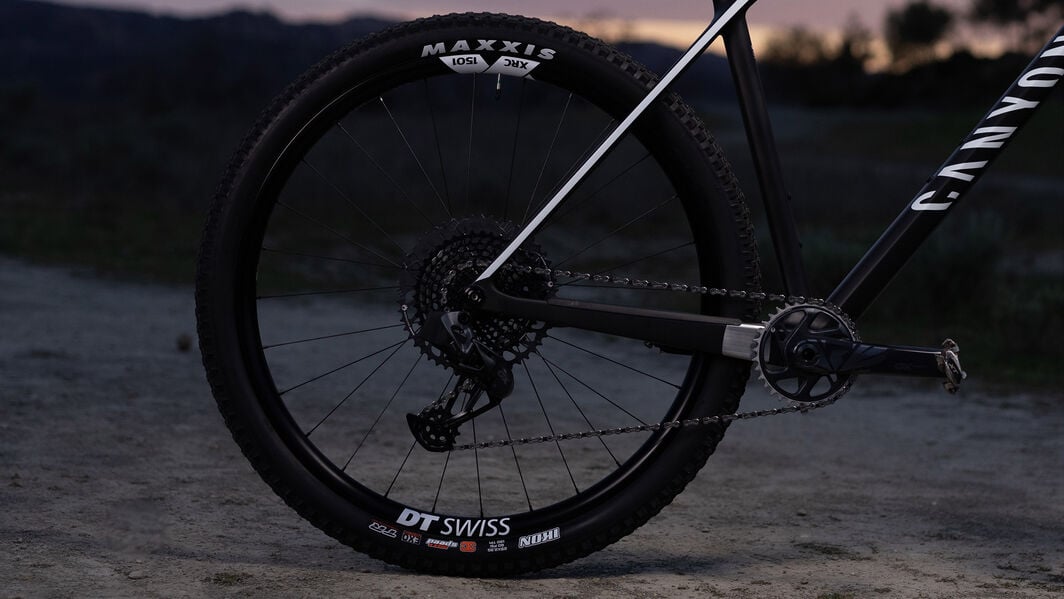
MTB drivetrain: 1x12 or 2x11?
The choice between a 1x12 or 2x11 drivetrain depends mainly on your personal riding style and your desired range of gears. The drivetrains also differ in weight and maintenance requirements.
2-by drivetrains, with an additional chainring on the crank, offer a wider range of gears in finer increments than 1-by drivetrains. However, they are heavier than 1-by drivetrains due to additional components and call for more maintenance and installation effort.
The gear range has long favoured a 2x11 mountain bike group set. Gear range indicates how large the difference is between the lightest and heaviest gear. Having a high gear range is great for mountain biking on rough terrain because it provides more gear options suitable for different riding conditions, allowing quick adaptation to changing conditions.
Why should you consider testing a 1x12 groupset?
With the introduction of 12-speed drivetrains by SRAM and Shimano, the topic of gear range has changed. Compared to an 11-speed drivetrain, these systems offer an additional gear at the rear, making the gear range on a 1x groupset competitive with systems that have two chainrings at the crank.
The large "dinner plates" on a 12-speed cassette may still divide opinion. However, the new 1x12 groupsets allow for well-graded gear ratios on the mountain bike thanks to the additional sprocket, with a gear range of between 500% and 520%.
Conclusion: 1x12 drivetrains combine the advantage of a wide gear range, which was previously only possible with a 2x11 system, with the simplicity and weight advantages of a 1x transmission.
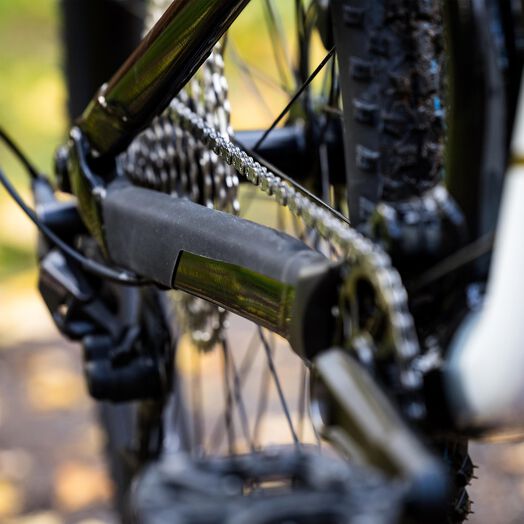
Calculating gear range: The gear range of a transmission indicates the ratio between the largest and smallest gear. For a 1x transmission, it can be easily calculated using the following formula:
- (Largest sprocket teeth/Smallest sprocket teeth) x 100 = Gear range as a percentage
- For example, for the SRAM Eagle 12-speed cassette with a 10-52 tooth range: (52/10) x 100 = 520% gear range.
What are other advantages of 1x12 drivetrains?
The best part: You will never have problems with the front derailleur again!
Since 1x groupsets only use one chainring on the crankset, you no longer need a front derailleur. Say goodbye to chain drops while shifting! This also means fewer parts that can break or need maintenance. Plus, you'll save weight on your setup.
Here are the advantages of a 1x12 MTB drivetrain summarised:
- Easy installation and indexing
- Low maintenance due to fewer wear parts
- Simple operation and less risk of shifting errors
- No chain jams or drops caused by the front derailleur
- Clean appearance
- Reduced weight
- Gear range of 500% to 520% possible as a 1x drivetrain
As you can see, there are many reasons to choose a 12-speed setup. This is also why MTB manufacturers, including Canyon, currently almost exclusively rely on 1x12 drivetrain systems.
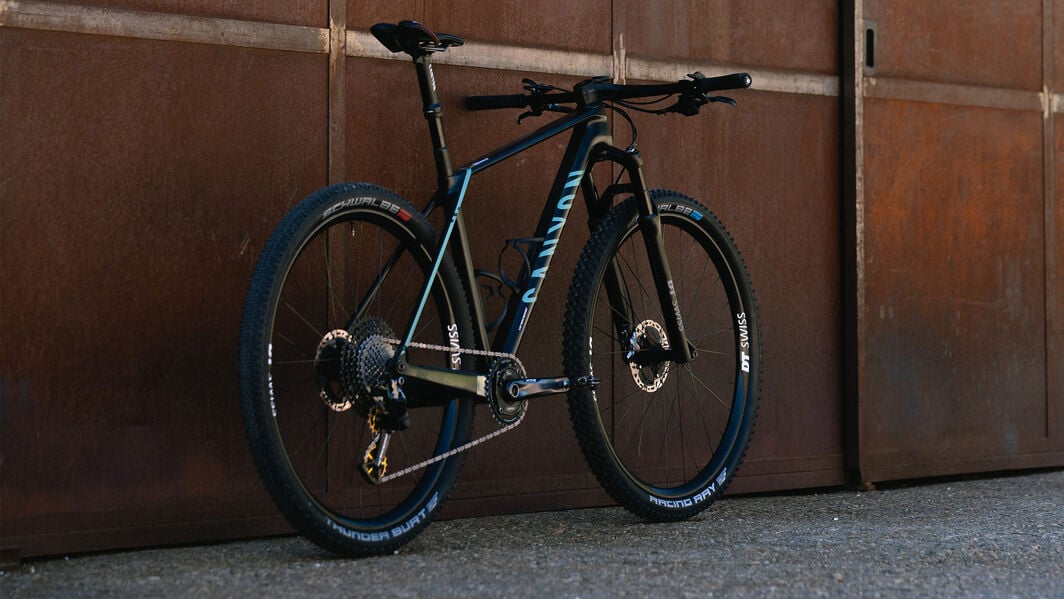
Disadvantages of 1x12 drivetrains
What are the disadvantages of 1x12 drivetrains if the gear range problem of 1x11 drivetrains is now resolved? The gear range does not reflect the entire range of gears, but only the ratio between the largest and smallest gear. The gear steps within the gear range of a 1x12 drivetrain can still have disadvantages depending on the riding style.
- Large gear changes require several shifts across the entire cassette
- Larger gear steps can be disruptive during acceleration
- The polygon effect causes greater wear on the 10-tooth cog and chain
- To shift the gear range between flatland and mountain riding, you need to change the chainring
Changing chainrings for new horizons
Although changing chainrings may require more effort than using a front derailleur, it can still be done with minimal mechanical experience. For instance, if you live on the coast and love mountain biking when you’re on holiday, you can customise your mountain bike's gearing by using various chainring sizes.
By using a small chainring of 30 or 32 teeth, you can conquer any uphill with your MTB. On flat terrain, a larger chainring with 34 teeth or more will give you better performance. However, it's important to remember that you should always adjust the chain length accordingly.
You can find all the replacement and wear parts for your bike, including the suitable chainring for your crankset, in your Canyon Bike Garage.
12-speed MTB groups: Shimano or SRAM?
Shimano and SRAM remain the major players in the gear market, with Shimano being a Japanese manufacturer and SRAM being based in the US. When it comes to choosing between Shimano and SRAM for an MTB, it largely depends on your personal preferences and requirements.
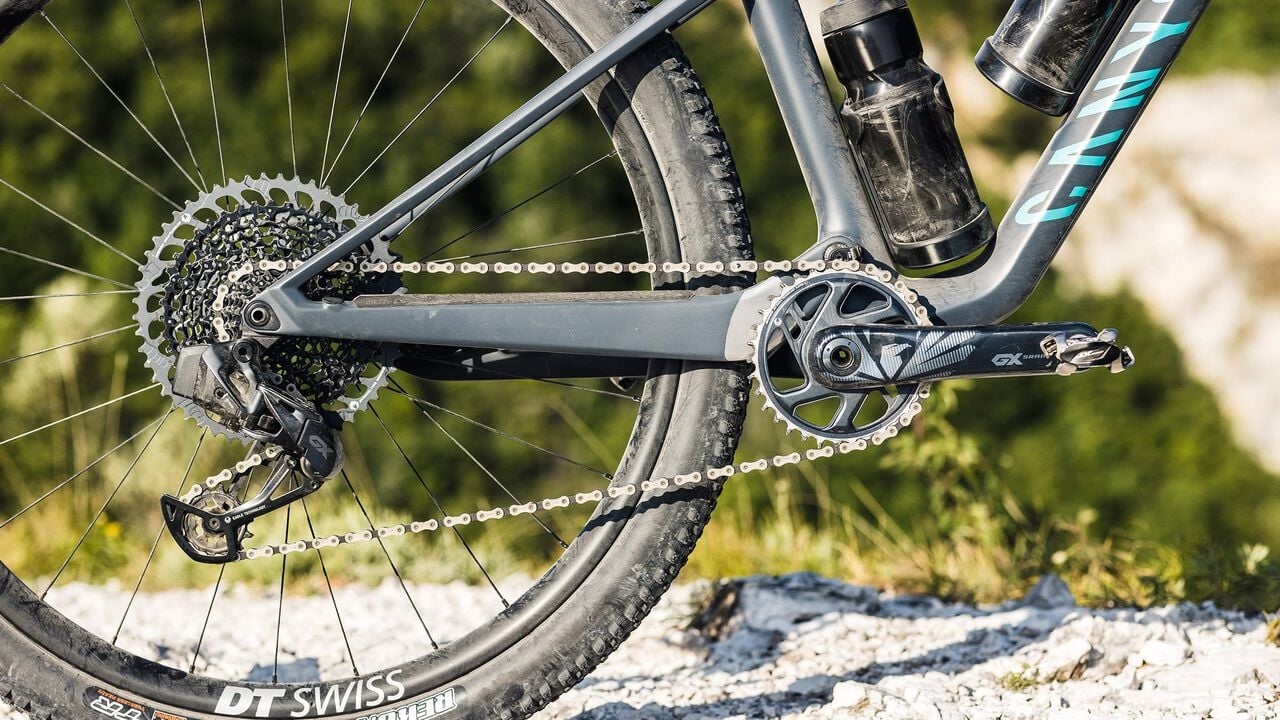
What 1x12 groups are available for mountain bikes?
SRAM has made 1-by transmissions popular, and in 2016, the American manufacturer introduced the first 1x12 drivetrain. Currently, the following SRAM MTB groupsets are available in the 12-speed range:
SRAM 12-speed MTB mechanical groupsets:
- NX Eagle
- GX Eagle
- X01 Eagle
- XX1 Eagle
SRAM 12-speed MTB electric groupsets:
- Eagle AXS Transmission (X0/XX/XX SL/GX)
- XX1 & X01 Eagle AXS
- GX Eagle AXS
SRAM 12-speed cassettes and gear range:
For the SRAM XD freehub, there are SRAM 12-speed cassettes available in the 10-50 and 10-52 gradations, which correspond to a gear range of 500% and 520%, respectively. For the standard HG freehub, the SRAM NX 11-50 is available as a 12-speed cassette. However, this cassette has 11 teeth on the smallest cog resulting in a gear range of 454%.
Shimano introduced their own 12-speed technology in 2018, and what sets them apart is that their MTB groups come in both 1x12 and 2x12 drivetrains.
Shimano 12-speed MTB mechanical groupsets:
- Deore
- SLX
- Deore XT
- XTR
Shimano 12-speed MTB electronic groupsets:
- Shimano DEORE XT Di2 (E-MTB shifting system, integrated into Shimano EP8 Shimano 12-speed
Shimano 12-speed cassettes and gear range:
The Shimano 12-speed cassette with a 10-51 ratio provides a gear range of 510% for a single chainring setup. The configuration for two chainrings (26-36 teeth) combined with the corresponding 10-45 sprocket pack offers a gear range of 623%. This is an alternative for those who seek an even closer range of gear ratios and do not wish to forego the front derailleur even with a 12-speed setup.
In our guide to MTB drivetrains, we explain each groupset in detail. Here, you will also get an overview of other alternatives to 12-speed drives and how an MTB transmission works in general.
12-speed MTB drivetrains: Mix and Match - what is possible?
The following components are part of a 1x12 transmission for a mountain bike:
- Crankset
- Chain
- Cassette
- Rear derailleur
In addition, there are the brakes and brake levers. Together, these components form the groupset of your MTB. All of these components are available in different designs and price ranges from both SRAM and Shimano. They often differ in materials, performance, and weight.
The SRAM Eagle system is specifically designed to allow you to mix and match components from different price ranges. This way, you can gradually upgrade your drivetrain. You can choose which component you would like to save money or weight on, depending on your preferences.
It is also possible to mix components from different groupsets with Shimano. However, for the best performance with a 12-speed drivetrain, Shimano recommends sticking to components within the same range.
Can Shimano be combined with SRAM?
With mechanical drivetrains, both manufacturers are theoretically combinable – for example when dealing with spare part emergencies or while tinkering with combinations of parts from different manufacturers. Especially old 8-speed systems give bike tinkerers and gearheads the freedom to opt for any combination they want.
However, it is not recommended to do this in the long term with modern groupsets, especially 12x systems. The drivetrain parts are designed to work optimally when matched within the same range for best performance. Mixing SRAM and Shimano components can result in increased wear and reduced shifting performance.
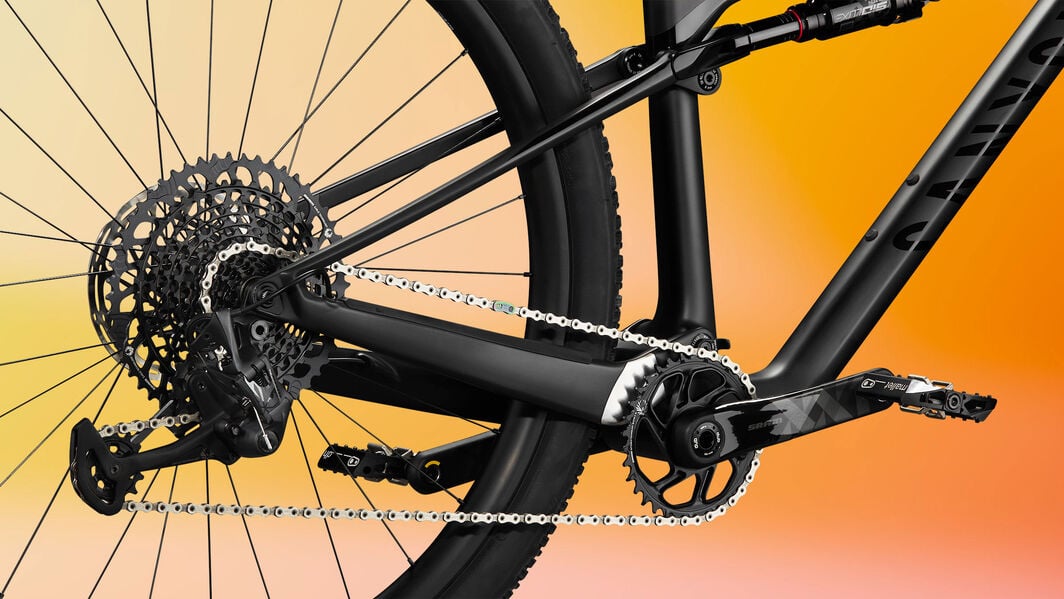
Mechanical or electronic shifting for MTB?
There are currently two systems for operating MTB derailleurs:
- Mechanical: using shift cables
- Electronic: through electronic impulses
Electronic shifting is already the standard for road bikes. Even gravel bikes are increasingly sold with eTap or Di2 options. Electronic shifting is slowly making its way into the world of mountain biking as well. SRAM made pioneering efforts in the market with the electronic 12-speed shifting for MTBs. Currently, Shimano offers the Di2 technology for 12-speed shifting only for e-MTBs. However, the Shimano XT Di2 is available as a 2x11 or 1x11 for MTBs.
Electronic shifting systems come with their own advantages and disadvantages. Your riding style and budget will decide which system is best for you. Here is an overview:
Advantages of electronic MTB shifting:
- Intuitive operation and indexing
- No need for cable tension adjustment
- Precise shifting
- Very fast shifting across multiple gears with a single click
- Additional control of electronic dropper posts or other devices
- SRAM AXS allows for MTB derailleur and cassette on a gravel bike (mullet build)
Disadvantages of electronic MTB shifting:
- Higher costs for purchasing and replacing parts
- Batteries need to be regularly charged
- Repairs are more complicated and often not possible on the trail
Road meets MTB: 12-speed Mullet Build with SRAM AXS
Party at the front. Business at the back. The electronic 12-speed system from SRAM allows for a Mullet drivetrain. This is a benefit that especially appeals to the niche of adventurers and ultra-bikepackers who ride with drop-bar MTBs or adventure gravel bikes.
The eTap AXS components allow for MTB Eagle AXS derailleurs to be operated with electronic road shifters (Rival or Force). 10-51 or 10-52 MTB cassettes offer enough bailout gears for a fully loaded gravel bike on remote mountain passes or challenging terrain.
Before the introduction of SRAM Eagle AXS, the only way to achieve this was through multiple hacks and aftermarket components in mechanical systems due to differences in cable tensions. In the second half of 2023, SRAM introduced mechanical Apex XPLR shifters with the same pull ratio for Eagle MTB derailleurs giving the option for a mechanical mullet gear setup. Shimano followed this demand with a new 1x12 GRX solution that allows cassettes from the MTB range with granny-friendly 51 teeth in the smallest gear to be used on gravel bikes.
Can I convert my old MTB to 12-speed?
In most cases, you can convert your old MTB to a new 1x12 system regardless of the axle width and wheel size.
Before converting to 1x12 on your MTB, you need to check the compatibility of the following components:
- Freehub
- Cassette
- Chain
- Chainring
- Rear derailleur and shifter
-
Freehub: The crucial factor when converting is the compatibility of the freehub. SRAM developed a solution with the XD body during the 1x11 era to make room for the 10-tooth cog. The SRAM XD standard also accommodates SRAM's 12-speed cassettes and offers a good selection of third-party cassettes.In contrast, the Shimano Micro Spline standard is relatively new and designed exclusively for Shimano 12-speed cassettes of the Deore, SLX, XT, and XTR grades.However, the HG standard freehub (from 8-speed) can also accommodate 12-speed cassettes from SRAM (NX) and third-party manufacturers, but the smallest cog is limited to 11 teeth.Many hub manufacturers such as Hope or DT Swiss offer simple conversion kits to new freehub systems for their high-end rear hubs.
-
Cassette: When converting to a 1x12 system, it is important to choose a cassette that is compatible with the current freehub. If the MTB has an older HG freehub, there are 12-speed cassettes available from Shimano and SRAM, as well as from third-party manufacturers. However, upgrading to 12-speed is not possible with screw-on freewheel hubs. In such cases, it is necessary to use a different hub on the rear wheel.
-
Chain: When selecting a chain, be sure to check for the 12-speed label. It's recommended to opt for a chain from the same manufacturer as your cassette. Ensure that the chain length is always customized to fit the cassette and the size of the chainring you're using.
-
Chainring: A 12-speed chainring works best with a so-called narrow-wide tooth profile. This special design of the teeth prevents the chain from slipping. You can either install this on your existing 1x crankset or purchase a new crankset for it.When choosing a chainring, make sure to consider whether your crankset is Direct Mount or requires a specific bolt circle diameter (BCD) for mounting. The chainring offset should also be chosen to match the crankset and the rear axle width of your MTB to ensure proper chain alignment.
-
Gear lever & derailleur: To achieve the best shifting performance when converting to a 12-speed drivetrain, you will need a 12-speed derailleur and corresponding gear lever. The derailleur should be from the same manufacturer as the gear lever. Depending on the cassette chosen, ensure that the derailleur has the correct cage length. SRAM and Shimano offer complete upgrade kits for the conversion, ensuring that all components are compatible with each other.
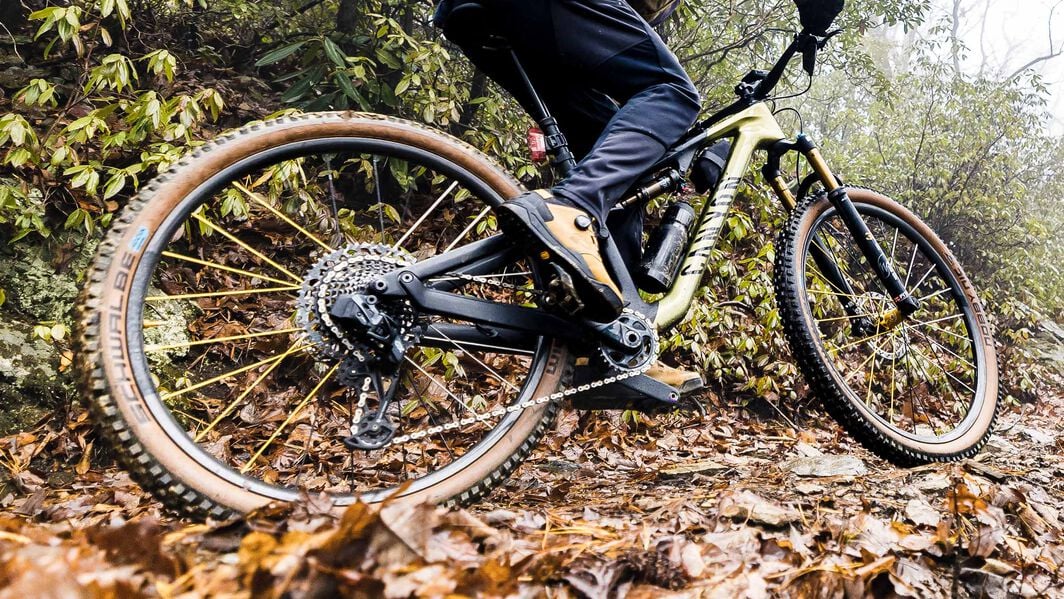
How to index a 12-speed MTB drivetrain
Adjusting a 12-speed gear system on an MTB is just as easy as adjusting the previous gear systems. In fact, it is even easier with a 1x system as there is no front derailleur to adjust.
Your Canyon MTB will arrive at your doorstep 95% pre-assembled, with the gears carefully indexed by the Canyon team before shipping. After your first few rides, the cables may stretch. You can find instructions on how to readjust the derailleur in the included manual.
MTBs with 12-speed drivetrains from Canyon
Canyon offers a wide range of mountain bikes with modern 12-speed drivetrains. If you're still undecided, our MTB buying guide can help you find your new trail partner: Which mountain bike is right for you?
Discover our Mountain Bikes
Did this article help?
Thank you for your feedback
-
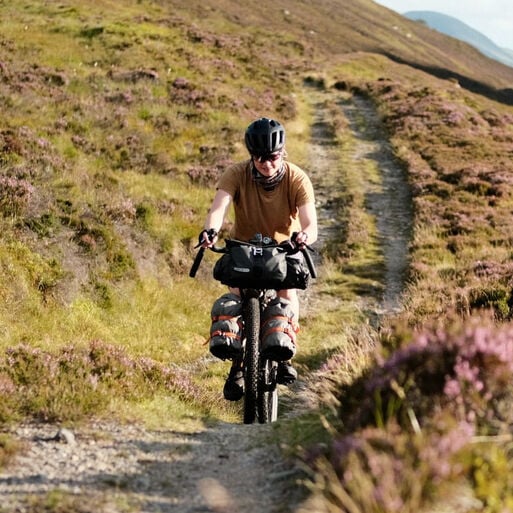 About the author
About the authorClaudia Krug
Meet Claudia, our SEO copywriter who switched from horseback riding to the excitement of exploring the wilderness and mountains of Europe on her bike. The passionate bikepacker, history buff and craft beer enthusiast dreams of one day riding The Great Divide. Join Claudia on her after-work rides around Leipzig, Germany, as she continues to explore the world on two wheels.
